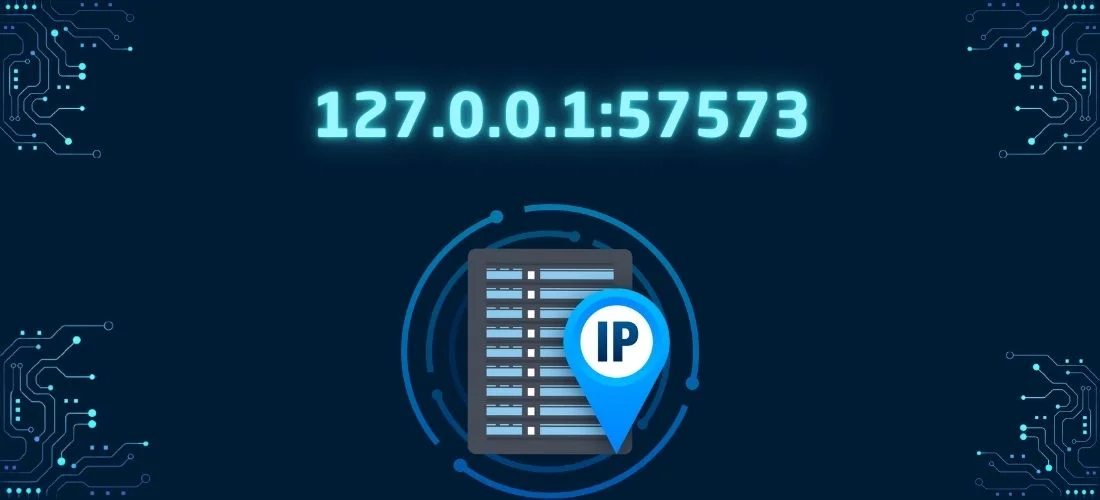
In the world of networking and software development, the term 127.0.0.1:57573 may not be immediately familiar to everyone, but it represents a fundamental concept in how computers communicate with themselves and manage internal processes. This combination of an IP address and a port number is often encountered by developers, system administrators, and IT professionals. To understand what 127.0.0.1:57573 signifies, it’s essential to break down its components and explore their significance.
What is 127.0.0.1?
The IP address “127.0.0.1” is known as the loopback address or localhost. It is a special IP address used by a computer to refer to itself. When a device sends a message to “127.0.0.1,” it is essentially communicating with itself. This is a standard networking practice used across all operating systems, including Windows, macOS, and Linux.
The loopback address is crucial for testing and development purposes. It allows developers to run services on their local machine without needing an external network connection. For instance, when a web developer is building a website, they can host it locally on “127.0.0.1” to test its functionality before deploying it to a live server.
What is Port 57573?
In the context of 127.0.0.1:57573, the number “57573” refers to a port. Ports are communication endpoints that allow different applications and services on a computer to exchange data. Each port is identified by a unique number, ranging from 0 to 65535, and serves as a channel for data transmission. Commonly used ports include 80 for HTTP, 443 for HTTPS, and 22 for SSH.
Port 57573 is an arbitrary number and is typically assigned dynamically by the operating system or chosen by the developer for specific purposes. In many cases, higher port numbers (above 1024) are used for custom applications or temporary connections, as they are less likely to conflict with well-known services that use lower port numbers.
The Role of 127.0.0.1:57573 in Development
When you see 127.0.0.1:57573, it usually indicates that a service or application is running locally on your machine and listening for incoming connections on port 57573. This is common in software development environments where developers need to test their applications in isolation before making them accessible over the internet.
For example, a web developer might run a local server that hosts a website on 127.0.0.1:57573. By typing this address into a web browser, the developer can interact with the website as if it were hosted on a remote server, even though it’s actually running on their own computer. This setup allows for rapid testing and debugging without affecting live environments.
Security Considerations
While 127.0.0.1:57573 is inherently secure because it only allows connections from the local machine, it’s important to manage and monitor which services are bound to specific ports like “57573.” Unintentionally exposing a sensitive service to the wrong port could lead to security vulnerabilities, especially if the service is later configured to accept external connections.
Developers should also be cautious when using ports in higher ranges, as these are sometimes used by other applications or services. Conflicts can occur if multiple services attempt to use the same port simultaneously, leading to unpredictable behavior or crashes.
Common Use Cases
- Web Development: Localhost addresses like 127.0.0.1:57573 are commonly used in web development environments where developers run web servers on their local machines to test applications before deployment.
- Database Access: Developers often run databases locally and connect to them using localhost addresses and specific ports. This allows them to test queries and database-driven applications in a controlled environment.
- Application Debugging: By running applications locally, developers can debug issues in real-time, monitoring how their code interacts with various services and responding to problems as they arise.
- Learning and Experimentation: For those learning about networking or server management, experimenting with localhost and various ports is a safe way to understand how different services communicate and interact.
Advanced Usage of 127.0.0.1:57573
 While 127.0.0.1:57573 is often used in straightforward scenarios like local development, its applications can extend into more advanced areas of software engineering and system administration. Understanding these advanced uses can help developers and IT professionals optimize their workflows and enhance the security and performance of their systems.
While 127.0.0.1:57573 is often used in straightforward scenarios like local development, its applications can extend into more advanced areas of software engineering and system administration. Understanding these advanced uses can help developers and IT professionals optimize their workflows and enhance the security and performance of their systems.
1. Virtualization and Containerization: In environments where multiple virtual machines (VMs) or containers are running on a single physical machine, “127.0.0.1” is often used to route traffic between these isolated environments. For example, each container might host a different microservice, and 127.0.0.1:57573 could be used to test one of these services before it interacts with others in the system. By assigning different ports to each service, developers can manage communication between containers effectively.
2. Reverse Proxies: A reverse proxy is a server that sits between client requests and backend servers, forwarding requests from the client to the appropriate server. In a local development environment, a reverse proxy might use “127.0.0.1” with various ports to simulate how requests are handled in a production environment. For instance, 127.0.0.1:57573 could be one of the ports used to route traffic to a specific backend service, allowing developers to test load balancing and failover scenarios.
3. Secure Local Development with Tunneling: When working on sensitive projects, developers may want to ensure that their local servers are secure, even when only accessible via localhost. Tunneling tools like SSH or Ngrok can be used to create secure connections to a local server running on 127.0.0.1:57573. This is particularly useful for remote debugging or testing applications in environments where security is a concern.
4. Custom Local DNS Resolution: In some advanced development setups, developers might configure their local DNS to resolve specific domains to “127.0.0.1.” This allows them to simulate production environments by using real domain names while still hosting services locally. For example, they could configure “dev.example.com” to resolve to 127.0.0.1:57573, enabling them to test how their application interacts with various subdomains and services.
Troubleshooting Common Issues with 127.0.0.1:57573
While using 127.0.0.1:57573 is generally straightforward, there are a few common issues that developers and system administrators might encounter. Understanding how to troubleshoot these problems can save time and prevent potential headaches.
1. Port Conflicts: A common issue arises when multiple services attempt to use the same port number. If another service is already using port 57573, trying to bind a new service to this port will result in an error. To resolve this, you can either stop the service currently using the port or choose a different port for your new service.
2. Firewall and Security Software: Sometimes, security software or firewalls on the local machine may block connections to certain ports, including 57573. If you encounter connection issues, check your firewall settings to ensure that the port is open and accessible. In development environments, it’s often useful to whitelist specific ports to avoid these issues.
3. Address Binding Issues: In some cases, a service might fail to bind to “127.0.0.1” due to incorrect configuration or insufficient permissions. Ensure that the service is correctly configured to use “127.0.0.1” and that it has the necessary permissions to bind to the specified port.
4. Network Configuration Conflicts: Network configurations, particularly in complex environments with multiple network interfaces, can sometimes cause conflicts with localhost traffic. It’s important to ensure that “127.0.0.1” is correctly routed to the local machine and that there are no conflicting routes or interfaces.
The Future of Localhost and Port Communication
As software development practices continue to evolve, the use of “127.0.0.1” and custom ports like “57573” will remain integral to the development and testing process. However, new technologies and methodologies may change how these tools are used. For instance, the rise of serverless computing and edge computing might reduce the reliance on local development environments, shifting more testing and development to cloud-based platforms.
Nevertheless, the fundamentals of localhost communication will remain relevant. Whether you’re building a microservice architecture, experimenting with new development tools, or simply running a local web server, understanding how to effectively use “127.0.0.1” and custom ports will always be a valuable skill.
Conclusion
The address 127.0.0.1:57573 may seem like just a string of numbers, but it represents a critical concept in networking and software development. By enabling developers to run and test services locally, it plays a vital role in ensuring that applications are functional, secure, and ready for deployment.
From basic local development to more advanced uses like virtualization, reverse proxies, and secure tunneling, the loopback address and port system offer a wide range of possibilities. By mastering these tools, developers and IT professionals can enhance their workflows, troubleshoot issues more effectively, and build more robust and secure applications.
You May Also Read: Retro Bowl 3kh0


